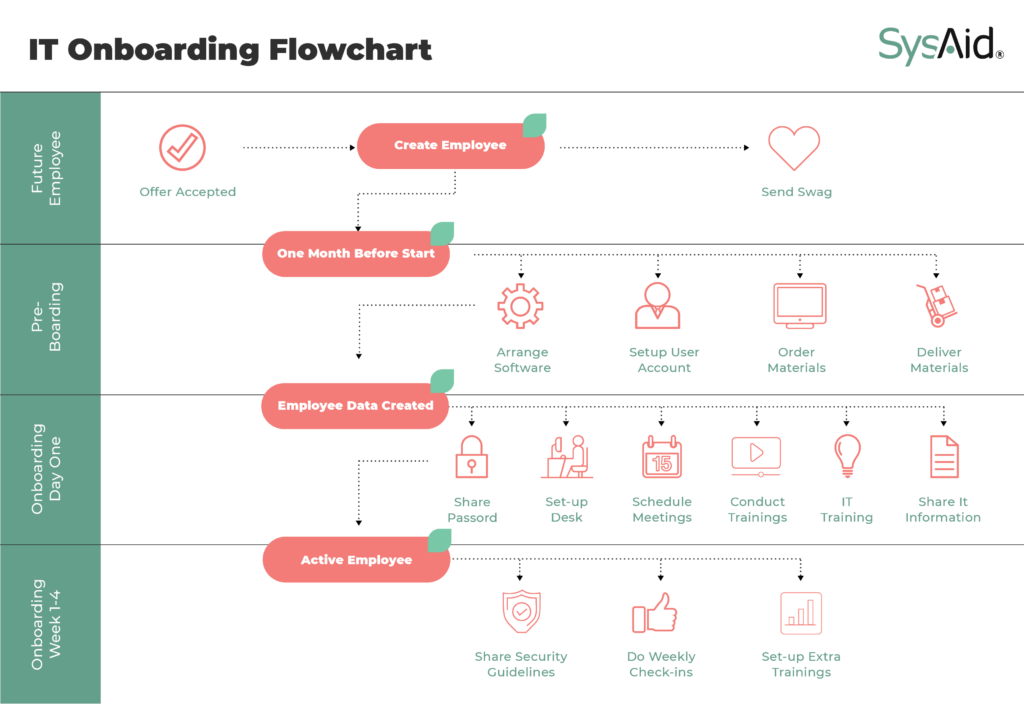What is IT Onboarding?
IT onboarding is the strategic process of integrating new personnel into the corporate digital ecosystem. It is a workflow that equips employees with the necessary tools, knowledge, and access to seamlessly navigate the corporate technology infrastructure. Such that they have all of the technology they need to do their jobs. An example of this is shown in the following IT Onboarding Flowchart.

Why is IT Onboarding Important?
The significance of IT onboarding cannot be overstated. It empowers your workforce to swiftly acclimatize to the corporate tech landscape, reducing downtime and accelerating their contributions. A well-executed IT onboarding process not only enhances productivity but also ensures data security and compliance and synchronizes the various departments that play a role in the employee’s onboarding to their role and the company. A simple example of the required cross-departmental working is shown below.
How to Create an IT Onboarding Checklist
Developing an IT onboarding checklist requires a thoughtful and structured approach. Consult with department heads and team leaders to gain insights into specific software, hardware, and access requirements their team members need.
Organize the checklist into a logical sequence, starting from pre-arrival tasks to first-day activities and ongoing support. Ensure that it’s comprehensive and easy to follow.
These aspects will help create a robust and adaptable IT onboarding checklist tailored to your organization’s needs. It will empower new team members to become proficient with your IT systems and tools while ensuring data security and compliance. What to include in an IT onboarding checklist is shared next.
What to Include on Your IT Onboarding Checklist
When creating an IT onboarding checklist for your organization, the following aspects should be considered:
- Collaborative Planning: Involve IT, Human Resources (HR), and department heads to identify specific IT requirements.
- Access Provisioning: Assign email accounts, network access, and software permissions promptly.
- Hardware Setup: Ensure that computers, phones, and other devices are prepared in advance, both with the required software, as well as end-point protection.
- Training Materials: Develop or curate resources for training on software, security protocols, and company systems.
- Security Protocols: Educate new hires on cybersecurity practices, password policies, and data protection.
- Software Installation: Provide instructions or support for installing essential software applications.
- User Accounts: Guide users in creating strong passwords and managing their accounts.
- Network Connectivity: Ensure Wi-Fi and network access are configured and functioning.
- IT Support Contact: Clearly communicate the IT helpdesk contact details for when assistance is needed.
- Feedback Mechanism: Establish a feedback loop to continually refine the IT onboarding process.
Evaluate the ease of setup and scale
Evaluating the ease of setting up an onboarding process involves assessing resource availability, technology readiness, documentation, and integration capabilities. Ensuring the necessary resources and technology infrastructure are available for a smooth setup is essential. Scalability, on the other hand, hinges on the checklist’s flexibility to adapt to changing organizational needs, the ability of technology to scale with company growth, and the checklist’s user-friendliness for various roles. Maintaining a feedback loop to identify and address scalability challenges is also vital for long-term success.
Schedule meetings for training
Scheduled IT training meetings during onboarding are crucial for tailored instruction, knowledge exchange, and fostering a culture of ongoing learning. These sessions ensure new hires receive the training they need to excel, enhancing efficiency while decreasing the need to rely on the IT department for help.
Inform employees on security policies
Informing employees about security policies during IT onboarding is paramount. It sets the foundation for a secure work environment. Start by clearly articulating policies, their importance, and the potential consequences of non-compliance. Use real-world examples to illustrate risks and best practices. Regular reminders and training sessions ensure that security policies stay top of mind. By fostering a culture of security awareness from day one, you create a resilient defense against threats and safeguard sensitive data effectively.
Automate the process
Automating IT onboarding offers numerous benefits, including increased efficiency, reduced errors, and enhanced security. The steps involved include identifying key onboarding tasks, creating workflows, and implementing tools for automated user provisioning and access management. By streamlining repetitive processes, you save time and resources. Additionally, automation ensures consistency in onboarding, reducing the risk of security breaches and enhancing the overall onboarding experience for new employees.
TIP – Automate!
Make sure your HR software is connected to your workflows. If an API or native integration with your IT workflow – add an email notification from the HR software to your ticket inbox that will trigger these workflows.
FAQ
What is IT onboarding?
IT onboarding is the strategic process of integrating new personnel into the corporate digital ecosystem. It is a workflow that equips employees with the necessary tools, knowledge, and access to seamlessly navigate the corporate technology infrastructure. Such that they have all of the technology they need to do their jobs.
What is included in onboarding?
The onboarding process includes access provisioning like email accounts, network access, and software permissions. It ensures that computers, phones, and other devices are prepared in advance with the right software and apps. There is also the dissemination of training materials, ensuring that employees know their way around the building and anything else an employee needs to successfully integrate into a company.
What is the typical onboarding process?
There is no definitive IT onboarding process; every company is different. However, there are similarities across organizations like hardware and software configurations, network access, getting the employee used to the programs they will use, who to turn to for IT support, etc.
Start Crushing IT
IT onboarding is the strategic process of integrating new personnel into the corporate digital ecosystem. It is a workflow that equips employees with the necessary tools, knowledge, and access to seamlessly navigate the corporate technology infrastructure. Such that they have all of the technology they need to do their jobs.
The onboarding process includes access provisioning like email accounts, network access, and software permissions. It ensures that computers, phones, and other devices are prepared in advance with the right software and apps. There is also the dissemination of training materials, ensuring that employees know their way around the building and anything else an employee needs to successfully integrate into a company.
There is no definitive IT onboarding process; every company is different. However, there are similarities across organizations like hardware and software configurations, network access, getting the employee used to the programs they will use, who to turn to for IT support, etc.



